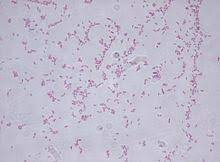Please click the frequently asked questions below for further information and IPC precautions required:
-
What is Stenotrophomonas Maltophilia?
Stenotrophomonas maltophilia is a gram-negative, aerobic bacterium that is most commonly found in aquatic environments. It is a low virulence organism which, in healthcare settings, may be found on environmental surfaces or prosthetic materials (e.g. central lines, catheters).
It is resistant to many antibiotic classes resulting in limited treatment options.

-
How does it spread?
It is a Contact Spread organism. Transmission is possible from contact with colonised environmental sources or the skin of colonised individuals.
-
What are the symptoms of Stenotrophomonas maltophilia?
Whilst it does not normally cause infections in healthy individuals, it has emerged as an important hospital acquired pathogen in vulnerable groups, including people with cystic fibrosis, underlying malignancy, immunosuppression and those with indwelling medical devices e.g. urinary catheters, mechanical ventilation.
In these at-risk groups, S. maltophilia can cause bloodstream infections, respiratory infections, urinary infections and surgical site infections.
-
Why is this important?
If NIAS staff are aware that the patient has a suspected or confirmed S. maltophilia, this should be communicated to EAC / NEAC and the receiving unit when transferring the patient to ensure effective patient care and management. This is particularly essential if the patient is immunosuppressed or is being admitted to NICU or other augmented care areas.
-
IPC Precautions
- Standard Precautions should be used.
- Contact Precautions may be required with high risk patients such as those who are immunosuppressed or Neonates. This can be discussed with the IPC team.
- Hand Hygiene should be completed as per the 5 moments in line with usual practice.
- Eye protection should be risk assessed for any concern regarding a splash risk.
- Gloves and Aprons should be risk assessed and worn if contact with the patient’s blood or bodily fluids.
- Laundry should be treated as per standard policy.
-
What cleaning is required?
All equipment and the ambulance should have an in-between patient clean, paying particular attention to touch points.
-
Do staff need prophylaxis or follow up?
No staff follow up required.




